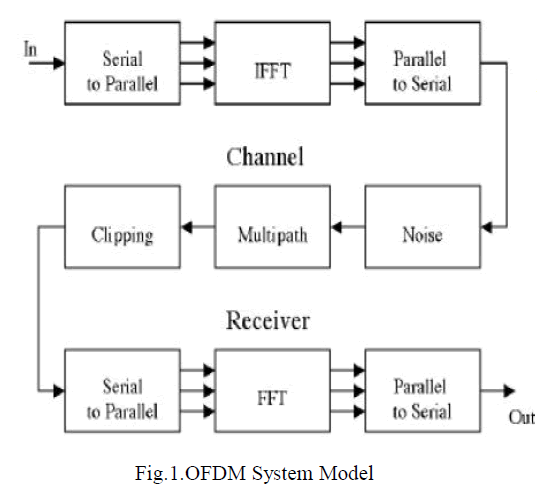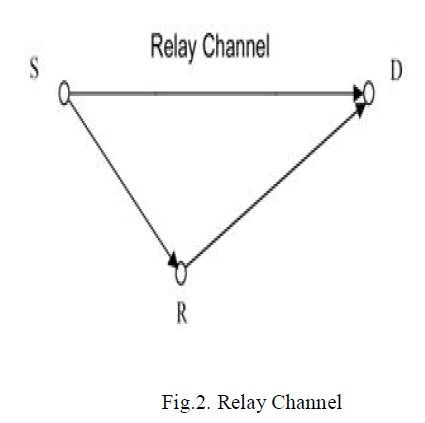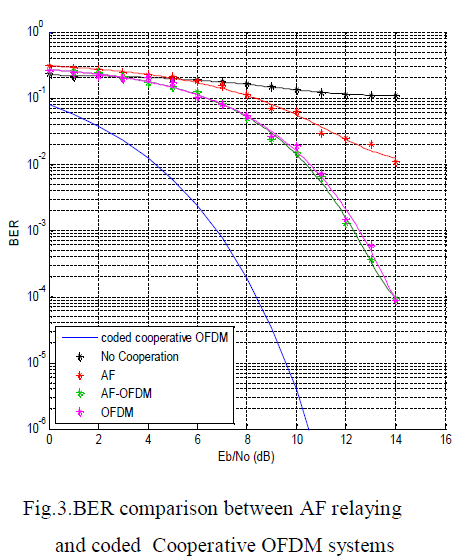Keywords
|
| Cooperative Diversity; OFDM; Amplifyand- Forward relaying; coded Cooperative relaying,; Decode and forward relaying |
I. INTRODUCTION
|
| OFDM is a combination of multiplexing and modulation. The signal is split into independent channels, modulated and then multiplexed to create an OFDM signals .The main concept in OFDM is the orthogonality of the subcarriers. The orthogonality allows simultaneous transmission on a lot of subcarriers in a tight frequency space without interference from each other. The attraction of OFDM is mainly due to how the system handles the multipath interference at the receiver. Multipath generates two effects: frequency selective fading and intersymbol interference (ISI). The "flatness" perceived by a narrowband channel overcomes the former, and modulating at a very low symbol rate, which makes the symbols much longer than the channel impulse response, diminishes the latter. |
| Cooperative communications is a new communication paradigm which generates independent paths between the user and the base station by introducing a relay channel. The relay channel can be thought of as an auxiliary channel to the direct channel between the source and destination. The basic idea behind cooperation is that several users in a network pool their resources in order to form a virtual antenna array which creates spatial diversity. There are mainly two relaying protocols in cooperative relay networks Amplify-and-Forward (AF) and Decodeand- Forward (DF).This paper studies the performance of the amplify and forward in an OFDM system. |
II.ORTHOGONAL FREQUENCY DIVISION MULTIPLEXING
|
| The basic principle of OFDM is to split a high-rate data stream into a number of lower rate streams that are transmitted simultaneously over a number of subcarriers. Because the symbol duration increases for lower rate parallel subcarriers, the relative amount of dispersion in time caused by multipath delay spread is decreased. Intersymbol interference is eliminated almost completely by introducing a guard time in every OFDM symbol. In the guard time, the symbol is cyclically extended to avoid intercarrier interference. In OFDM design, a number of parameters are up for consideration, such as the number of subcarriers, guard time, symbol duration, subcarrier spacing, and modulation type per subcarrier. The choice of parameters is influenced by system requirements such as available bandwidth, required bit rate, tolerable delay spread, and Doppler values. The Fig.1. Shows the OFDM system model, the series and parallel converter is considered to realize the concept of parallel data transmission. |
| In a conventional serial data system, the symbols are transmitted sequentially, with the frequency spectrum of each data symbol allowed to occupy the entire available bandwidth. When the data rate is sufficient high, several adjacent symbols may be completely distorted over frequency selective fading or multipath delay spread channel. The spectrum of an individual data element normally occupies only a small part of available bandwidth. Because of dividing an entire channel bandwidth into many narrow sub bands, the frequency response over each individual sub channel is relatively flat. A parallel data transmission system offers possibilities for alleviating this problem encountered with serial systems and also the resistance to frequency selective fading [8]. |
 |
| The process of mapping the information bits onto the signal constellation plays a fundamental role in determining the properties of the modulation. An OFDM signal consists of a sum of subcarriers that are modulated by using phase shift keying (PSK) or quadrature amplitude modulation (QAM).In this paper QAM has been considered [7]. |
| OFDM-based wireless communication systems append Cyclic Prefix (CP) to provide robustness against multipath effects. To eliminate the effect of ISI, the guard interval (or cyclic extension) is used in OFDM systems to combat against multipath fading. To eliminate ICI, the OFDM symbol is cyclically extended in the guard interval. This ensures that delayed replicas of the OFDM symbol always have an integer number of cycles within the FFT interval, as long as the delay is smaller than the guard interval. |
III COOPERATIVE COMMUNICATION
|
| Cooperative techniques in wireless communication networks are the means to adopt the diversity, which is inherent in a wireless medium. The diversity achieved in a communication system, when such techniques are implemented, can be in code, frequency, space and time domains. The goal of cooperative diversity is to increase the reliability and the quality of service (QoS), coverage area range, and the data throughputs as well as improve the spectral efficiency of the wireless networks while prolonging the life of the nodes or user terminals by increasing energy efficiency [2]. |
 |
| Communication from a single source to a single destination without the help of any other communicating terminal is called direct, single-user or point-to-point communication. User-cooperation is possible whenever there is at least one additional node willing to aid in communication. The simplest and oldest form of usercooperation is perhaps multi-hopping. The relay channel is the three-terminal communication channel shown in Fig.2. The terminals are labeled the source (S), the relay (R), and the destination (D). All information originates at S, and must travel to D. The relay aids in communicating information from S to D without actually being an information source or sink.[5] |
| Relay selection and resource allocation play important roles in cooperative communication. When the channel between the source node and the destination node suffers from severe fading, the direct transmission from the source node to the destination node will have poor performance. By using the cooperative relaying scheme, the source node can find relay nodes which have better channels to the destination node. Adopting these better relays to forward the signal to the destination node, the cooperative communication increases the reliability of the whole transmission. Selecting the relay nodes closer to the source node, it can also save battery power, since the source node does not have to transmit at high power and can use the relays’ power to perform the transmission instead. The saving of the power by relay selection in cooperative communication can contribute in this way to the so called “green communication” with low power transmission [6]. |
| There are two fundamental ideas based on which the source and relay nodes can share their resources to achieve the highest throughput possible for any known coding scheme. The cooperation strategies based on these different ideas have come to be known as relay protocols. The first idea involves decoding of the source transmission at the relay. The relay then retransmits the decoded signal after possibly compressing or adding redundancy. This strategy is known as the decode-and-forward protocol, named after the fact that the relay can and does decode the source transmission. The decode-and-forward protocol is close to optimal when the source-relay channel is excellent, which practically happens when the source are relay are physically near each other. The second strategy is amplify-and-forward protocol where the estimate of the source transmission is scaled up or down before retransmission. The amplification factor is dictated by the relative strengths of the source-relay and sourcedestination links. |
IV. AMPLIFY AND FORWARD COOPERATIVE RELAYING
|
| Amplify-and-Forward (AF) is the simplest way of cooperating. The source node transmits information not only to the destination node but also to the cooperation node at first, then the cooperation node amplifies the received signal directly and forwards it, the destination node receives and combines the two signals [1]. Though the noise is amplified while the cooperation node amplifies the signal received from the source node, the signal can still be made better judgments in the destination node because the two signals has experienced independent fading. Frequently we use this way when the cooperation node has a limit computing time and power or a time delay, the time delay is a result of encoding or decoding of information. The cooperation node cannot employ the two cooperative protocols Amplify-and-Forward (AF) and Decoded-and- Forward (DF) together [3]. In order to make the power of signal that is transmitted by the cooperation node equivalent to which was transmitted by the original node, the cooperation node needs to use an amplification factor which depends on the simulation environment. Amplify-and-Forward (AF) assumes that the base station can obtain the channel state information between users so as to make the best judgment to the received signal. Another issue of concern is the signal sampling, amplification and the retransmission of analog signal. Amplify-and-Forward (AF) is simple and easy to analyze, it helps us a lot in depth understanding of cooperative diversity |
V. DECODE AND FORWARD COOPERATIVE RELAYING
|
| Another way by which the relay can be processed at the relay node is to decode the received signal, re encode it, and then retransmit it to the receiver. This kind of relaying is termed as a fixed decode-and forward (DF) scheme. The signal decoded at the relay may be incorrect. If the incorrect signal is forwarded to the destination, the decoding at the destination is meaningless. DF relaying has the advantage over AF relaying in reducing the effects of additive noise at the relay. However, it entails the possibility of forwarding erroneously detected signals to the destination, causing error propagation that can diminish the performance of the system [4]. The main intention of DF scheme is to eliminate noise in the cooperation node to avoid the noise amplification. In this mode ,the mobile terminal is always trying to decode the received signals first and then forwards it to the destination node after encoding, so that the effects of noise which is generated at the cooperation node is removed. The cooperation node needs to decode the original information completely. The basic principle behind coded cooperation is that the overall rate for coding and transmission shall be the same. Better diversity is achieved in coded cooperation by rearranging the coded symbols between the two users .Cooperation is incorporated at the level of the channel coding subsystem, which is one of the main distinguishing features of coded cooperation comparing with the AF scheme. The relay repeats the bits sent by the source in the case of Amplify and Forward. However in case of coded cooperation the relay sends incremental redundancy, which when combined at the receiver with the codeword sent by the source, results in a codeword with larger redundancy [1] Convolution codes have been used in the paper with rate 1/2 and constraint length 3. |
V. COOPERATIVE OFDM
|
| Among the existing air-interface techniques, OFDM is a promising technique for high-bit-rate wireless communications. It possesses the advantages of frequency parallel transmission, high speed communication and efficient spectrum usage. In the cooperative OFDM network, relays located between transceiver stations will receive the information transmitted by source much more reliably than destination, and in turn it needs to use a dramatically smaller transmit power to reach the destination. Relaying can mimic multiple-antenna systems even when the cooperating terminals can individually only support a single antenna. With multiple antennas, it is possible to send multiple copies of the same signal to improve reliability. This gain in reliability is called diversity. When transmitted through the multipath channel, OFDM can help that cooperative communication gain from multipath diversity. Alternatively, it is also possible to transmit several parallel data streams thereby increasing rate. This increase in rate is called as multiplexing gain. Cooperative OFDM Network obtains the capability in spatial diversity, and also increase in the transmission rate. |
| In this paper, amplify and forward cooperative diversity technique is applied to OFDM system. The signal is transmitted through the sender of OFDM system after it was processed. Not only the receiver receives the signal but also the cooperation node does, then the cooperation node will transmit the signal to the destination node. At the same time, the source node can retransmit the signal or transmit the new signal, at last the destination node will combine the two received signals based on some protocols. Maximal ratio combining has been used at the receiver. |
 |
VI. CONCLUSION
|
| The simulation result in the Fig.3 shows the bit error rate performance comparison between direct transmission, OFDM transmission, Amplify and forward relaying, AFOFDM system and coded OFDM system. As can be seen from the result coded OFDM system gives a better performance over the amplify and forward-OFDM system as the noise is not getting amplified and the redundancy term added checks and corrects the error before retransmitting the re-encoded message at the relay node. However the performance of AF and AF-OFDM system are almost the same as the noise also gets amplified. This paper is a study on applying Cooperative Diversity to OFDM system. The result of simulation demonstrates that the OFDM system has a better performance when the cooperation node employs coded cooperative scheme. In the simulation, Rayleigh multi-paths fading channel, convolution coding maximum ratio combining has been considered. The simulation results show that the OFDM system with coded Cooperative relaying has a better performance over the AF cooperative scheme. |
| |
References
|
- Laneman, J. N., Tse, D. N. C., and Wornell, G. W.,“Cooperative diversity in wireless networks: Efficient protocols andoutage behavior,” IEEE Trans. Inform. Theory, vol. 50, pp. 3062–3080, Dec. 2004.
- Zhao Xianjing, ZhengBaoyu, The Theoretical BERPerformance Analysis of a Cooperative Diversity Scheme inFrequency Selective fading channel: JOURNAL OFELECTRONICS(CHINA), November 2007
- H. Lu and H. Nikookar, “A thresholding strategy for DF-AFhybrid cooperative wireless networks and its performance”, Proc.IEEE Symposium on Communications and Vehicular Technology,(SCVT ’09), UCL, Louvain, Nov 2009.
- A. Nosratinia, T. E. Hunter, and A. Hedayat, “Cooperativecommunciation in wireless networks,” IEEE Commun. Mag., vol. 42,pp. 74-80, Oct. 2004.
- A. Sendonaris, E. Erkip, and B. Aazhang, “User cooperationdiversity—Part I: System description,” IEEE Transaction onCommun., vol. 51, no. 11, pp. 1927-1938, Nov. 2003.
- A. Sendonaris, E. Erkip, and B. Aazhang, “User cooperationdiversity—Part II: Implementation aspects and performance analysis,”IEEE Trans. Commun., vol. 51, no. 11, pp. 1939-1948, Nov. 2003.
- R. van Nee and R. Prasad, OFDM for Wireless MultimediaCommunications. Norwell, MA: Artech House, 2000.
- Batra, A.; Balakrishnan, J.; Aiello, G. R. &Dabak, A. (2004).Design of a multiband OFDM system for realistic UWB channelenvironments, IEEE Transaction on Microwave and Techniques, Vol.52, No. 9, pp. 2123–2138, ISSN: 0018-9480
|